Deepwater Horizon oil spill
![]()
This article or section needs a revision: Very contemporary account with many speculative parts, but clarified today. Large parts are more like a current reportage than an encyclopedia article. The following presentation does not correspond to the state of researchPlease
help to improve it, and then remove this marker.
![]()
This article or subsequent section is not sufficiently supported by evidence (e.g., anecdotal evidence). Information without sufficient evidence may be removed in the near future. Please help Wikipedia by researching the information and adding good supporting evidence.
very many weblinks are broken
The 2010 Gulf of Mexico oil spill was caused by the explosion of the Deepwater Horizon oil rig on April 20, 2010. The amount of oil spilled from the well in the Macondo oil field into the Gulf of Mexico from 20 April to 16 July 2010 is estimated at 800 million litres; therefore, the accident is considered one of the most severe environmental disasters of its kind. Similarly large quantities of crude oil spilled in 1979/80 in the Ixtoc-I well blowout. In mid-2015, the oil company BP reached an agreement with the US government to pay damages totalling USD 18.7 billion, which is the highest figure in US history.
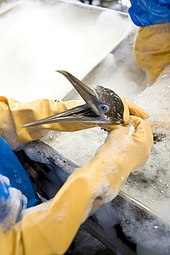
Washing a pelican
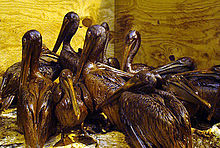
Oil-smeared pelicans
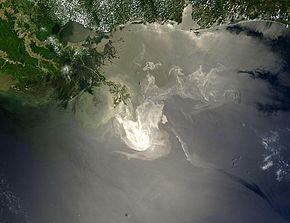
Extent of the oil spill in the Gulf of Mexico on 24 May 2010 (NASA image). The image width corresponds to about 540 km.
Cause
→ Main article: Deepwater Horizon
On 20 April 2010, an explosion occurred on the Deepwater Horizon oil rig, built in 2001 and operated by Transocean on behalf of the British company BP, after natural gas escaped from the well, killing eleven people and causing the rig to sink two days later. Internal documents of the BP group show that, despite warnings from experts, an inexpensive method with a greater risk of gas leakage was deliberately chosen to seal the borehole.
Until 16 July 2010, when the oil outflow was stopped by a temporary closure, crude oil and natural gas were flowing out of the well at a water depth of 1500 metres at a pressure of about 900 bar (blowout).
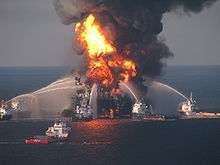
Deepwater Horizon on fire
Amount of oil released and oil spill
Immediately after the sinking of the platform, an oil slick of about 1.5 km × 8 km was observed, which after a few days extended to an area of more than 9,900 square kilometres.
The amount of oil leaking cannot be reliably measured and the estimates given have been repeatedly revised upwards. According to a figure from 15 June 2010, an estimated 5.6 to 9.6 million litres (35,000 to 60,000 barrels) flowed out daily. The figures are based on the Flow Rate Technical Group (FRTG) of the US Department of the Interior under the leadership of Admiral Thad Allen, who was appointed by US President Obama to deal with the crisis, with the assistance of the Secretary of Energy Steven Chu and the Director of the United States Geological Survey, Marcia McNutt. The new estimate is based on improved analysis of video footage from the well. As recently as June 10, the estimate was 4 million to 4.8 million liters (25,000 to 30,000 barrels); on May 27, it was 2 million to 4 million liters (12,000 to 25,000 barrels). An unspecified amount of the oil was collected and extracted from June 5 by a steel cap installed by BP, the company responsible for the well; according to reports on June 27, about 1.6 million liters (10,000 barrels) of it were burned daily and 2.4 million liters (15,000 barrels) were discharged to tankers. The total amount of oil spilled was estimated at 500,000 to 1 million tons in mid-2010.
Other calculations by researchers, such as Steve Werely of Purdue University, put the spill at between 8 and 14 million liters (50,000 to 84,000 barrels) a day. In reports on May 28, U.S. government experts spoke of the worst oil spill ever in the United States. According to FRTG estimates, as much oil has been spilled about every eight to ten days as was spilled in total from the 1989 Exxon Valdez tanker accident in Alaska.
On 17 June 2010, BP announced that an estimated seven billion litres (43 million barrels) of oil were still in the affected well. It would therefore take another two to four years until the total amount had flowed into the sea.
On April 29, 2010, the first foothills of the oil spill hit the Louisiana coast and thus the Mississippi Delta.
On the same day, the spill was declared a national disaster by the US government. Thus, parts of the US armed forces could be deployed to fight the oil spill. In addition, BP officially requested the assistance of the US armed forces in combating the oil spill and assumed financial responsibility for the measures necessary to stop the oil spill, although this voluntary commitment can hardly be regarded as legally binding before the liability cap of 75 million US dollars enshrined in law in the United States. A state of emergency was declared in the states of Louisiana, Florida, Mississippi and Alabama. In early July 2010, the oil also reached the coast of Texas.
In late June 2010, a WHOI submersible detected a 35-kilometer-long plume of monoaromatic petroleum hydrocarbons at a depth of 1100 meters, with an average width of 1.9 kilometers and a vertical extent of 200 meters, which showed no signs of bacterial decomposition.
On 15 July 2010, BP and the media reported that it had succeeded in closing the valves of a containment cylinder. For the first time since the disaster began at the end of April, no more oil was flowing into the sea. Whether the seal would withstand the pressure of the oil flowing out in the long term, however, was still unclear at that time.
On 19 July 2010, it became known that, according to the US government, engineers had discovered seeps less than three kilometres from the well. Therefore, a leak was suspected, which would allow further oil to escape. In addition, in this case, the valves of the new containment bell would presumably have to be opened in order to relieve pressure from the already destabilized seabed and to be able to further control the situation. In addition, oil would again flow into the sea for about three days if BP decided to transfer the oil from the well directly into tankers, because the pressure would have to be reduced for the necessary work and the valves would have to be opened for this. Single image analysis of a high resolution film recording of the blowout event, lasting about 50 seconds, allowed the amount of petroleum spilled to be calculated. The determination of solids in the fluid stream and the creation of a path/time calculation, taking into account the known borehole cross-section, enabled a viable volume determination. According to this, with an uncertainty range of approximately ±20%, between April 20 and July 15, 2010, when the first tight-fitting cap was flanged on the damaged well, between 8.9 and 10.8 million liters of oil flowed into the sea every day. By the end of the oil spill, some 700 million litres (4.4 million barrels) had thus flowed into the Gulf of Mexico.
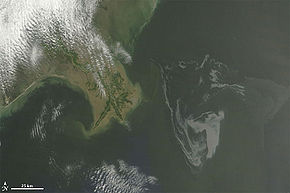
Satellite image of the Mississippi Delta on May 1, 2010. The oil spill is visible to the right of the center of the image.
Questions and Answers
Q: What is the Deepwater Horizon oil spill?
A: The Deepwater Horizon oil spill is the largest marine oil spill in history, also known as the BP oil spill, the Gulf of Mexico oil spill, or the Macondo blowout.
Q: How did the spill occur?
A: The spill occurred in the Gulf of Mexico when the drilling machines exploded on April 20, 2010, causing an oil gusher.
Q: How many people were killed and injured in the explosion?
A: The explosion killed 11 workers and injured 17 people.
Q: When was the leak stopped?
A: The leak was stopped on July 19, 2010, by putting a cap on top of the broken well pipe.
Q: How much crude oil spilled out before the well was fixed?
A: About 7.9 million barrels (780×103 m3) of crude oil spilled out before the well was fixed.
Q: What were the damages caused by the oil spill?
A: The oil spill damaged animal and plant habitats, Gulf's fishing and tourism businesses, and oil underwater that could not be seen from the top. People worked to protect hundreds of miles of beaches and estuaries along the northern Gulf coast.
Q: Who was held responsible for the spill and what did they do?
A: The U.S. Government named British Petroleum (BP) as responsible for the spill, and the company paid for clean up and other damages. By the end of 2011, the U.S. Coast Guard’s Operational Scientific Advisory Team said that there were no more ocean areas needing special cleanup from the oil spill, but they were not sure of the condition of the shore.
Search within the encyclopedia